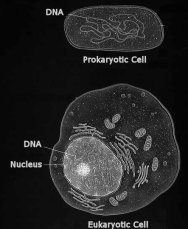Endosymbiosis - The Appearance of the Eukaryotes
Endosymbiosis - the Origin of Domain Eukarya |
Page within: Evolution | |
|
One theory holds that the mitochodrion evolved from small heterotrophic prokaryotes that were engulfed by a larger eukaryotic cell. The heterotrophic prokaryote used cellular respiration to intake oxygen and convert organic molecules to energy. The prokaryotic cells that were too small to be digested continued to live inside the host Eukaryotic, eventually becoming dependent on the host cell for organic molecules and inorganic compounds. Conversely, the host cell would have acquired, by the addition of the aerobic function, an increased output of ATP for cellular activities, leading an improved selective advantage. Under this theory, the prokaryotes that gave rise to all eukaryotes were probably from the domain Archaea both because several key characteristics and DNA comparison suggest that Archaeans are more closely related to the eukaryotes than are eubacteria. This is the so-called serial endosymbiosis theory of a monophyletic origin of the mitochondrion from a eubacterial ancestor. That fact that mitochondria have their own DNA, RNA, and ribosomes, supports the endosymbiosis theory, as does the existence of the amoeba, a eukaryotic organism that lacks mitochondria and therefore requires a symbiotic relationship with an aerobic bacterium. | ||
|
Fossil
Museum Navigation:
Home Geological Time Paleobiology Geological History Tree of Life Fossil Sites Fossils Evolution Fossil Record Museum Fossils | ||||||

